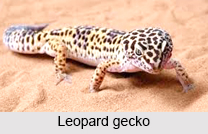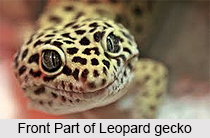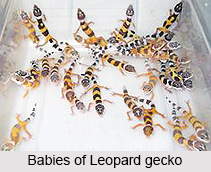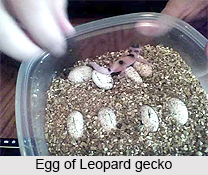 Leopard Gecko is an Indian Reptile that bears a scientific name "Eublepharis macularius" and is a crepuscular ground-dwelling lizard naturally found in the deserts of Asia and throughout Pakistan, to parts of northern India.
Leopard Gecko is an Indian Reptile that bears a scientific name "Eublepharis macularius" and is a crepuscular ground-dwelling lizard naturally found in the deserts of Asia and throughout Pakistan, to parts of northern India.
Description of Leopard Gecko
Leopard Geckos were first described as a species by zoologist Edward Blyth in 1854 as Eublepharis macularius.
Habitat of Leopard Gecko
The native habitat of Leopard Gecko is the rocky, dry grassland and desert regions of south-Asian Afghanistan, Pakistan, north-west India, and some parts of Iran. Winter temperatures in these areas can be quite low, below 10 degree Celsius forcing the animals underground into semi-hibernation, called brumation, living on fat reserves.
Behaviour of Leopard Gecko
Leopard Geckos are crepuscular reptiles; they are limited to the burrows during the day but become active at dawn and dusk when the temperature is favourable. These Geckos are solitary, and do not usually live with other animals
Feeding of Leopard Gecko
 Leopard Geckos feed on crickets, roaches, grasshoppers, wax worms, mealworms, super worms, other insects and earth worms. In captivity, most individuals will prefer hunting food themselves. The majority of captive leopard geckos will also refuse to eat dead prey. Crickets are the most common food source to give them in captivity, as they can hunt them in their enclosure the way they would in their natural environment, though mealworms and certain species of roach are also common. When food is scarce in the desert, they can rely on their ability to store excess fat in their tails.
Leopard Geckos feed on crickets, roaches, grasshoppers, wax worms, mealworms, super worms, other insects and earth worms. In captivity, most individuals will prefer hunting food themselves. The majority of captive leopard geckos will also refuse to eat dead prey. Crickets are the most common food source to give them in captivity, as they can hunt them in their enclosure the way they would in their natural environment, though mealworms and certain species of roach are also common. When food is scarce in the desert, they can rely on their ability to store excess fat in their tails.
Hatchling of Leopard Gecko
The hatchlings of Leopard Gecko tend to be 6.5 to 8.4 cm (2.6 to 3.3 inches) in length and weighing about 3 grams while the adult Geckos are about 20.5 to 27.5 cm (8.1 to 11 inches) in length and weight about 45 to 65 grams.
Size of Leopard Gecko
Leopard Geckos are found in the wild typically having a darker, dull, and drab coloration than those kept in captivity as pets. Those in captivity generally have an assortment of skin colours and patterns. The skin of a Leopard Gecko is very durable, which provides protection from the rough sand and rocky hill terrains of their dry environment. Their dorsal side is covered with small bumps, which gives a rough texture and appearance while their ventral side is thin, transparent and smooth. Like all reptiles, Leopard Geckos shed their skin. In a few days before the shedding, the skin will turn colour to a translucent whitish grey. Adults shed an average once a month, while juveniles will sometimes shed twice as much. The gecko will eat its old skin after shedding, revealing a brighter coloured one. There are two theories of why leopard geckos do this. One is that in the wild leopard geckos eat their shed skin so there is no trace that the Leopard Gecko was there. The other theory is that eating the shed skin is a means for obtaining protein and other vitamins for growth.
Temperature of the Body of Leopard Gecko
Leopard Geckos are eco-thermic. Leopard geckos absorb warmth and energy during the day as they are sleeping, so they can hunt and digest food at night. In addition, they have short legs, which enable them to be quick and agile while their small nails allow them to climb twigs and rocks. Leopard geckos have openings on either side of their head as ears. A tympanic membrane covers and protects it. They use their ears to locate their prey. Healthy leopard geckos have thick, fleshy tails; a thin tail is an indication that the gecko is not healthy and may be lacking nutrition. Although, when in captivity, the tail can be fattened by the feeding of waxworms (wax moth larvae), these worms are typically too fatty for the gecko to get the nutritional value it needs. They can also be fed "pinkys", a one-day-old mouse to fatten up the tail, but again, these are very low in nutritional value.
Teeth of Leopard Gecko
Leopard Geckos are Polyphyodonts and able to replace each of their 100 teeth every 3 to 4 months. Next to the full grown tooth there is a small replacement tooth developing from the odontogenic stem cell in the dental lamina.
Predators of Leopard Gecko
Leopard Geckos have predators such as snakes, foxes and other large reptiles. Their keen sense of hearing and sight help them escape during the night. Along with their exceptional sight and hearing abilities, their skin helps camouflage themselves from their predators. Their sense of taste and smell also helps them with survival. The shedding of their skin also removes any scent markers left behind for potential predators to discover. They also stay in underground holes and burrows during the daytime, not only to avoid the heat, but to also avoid the risk of getting eaten.
Leopard Gecko as Pet
Leopard Geckos are one of the most popular reptile pets. They are possibly the first domesticated lizard species. Their small size, robustness, and relatively easy care make them a good "beginner" reptile pet. They breed easily in captivity, so most sold today are captive-bred rather than wild-caught.



















